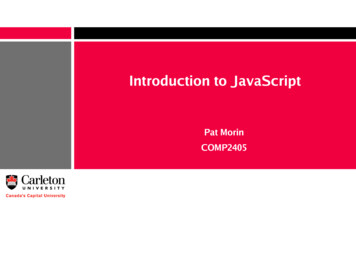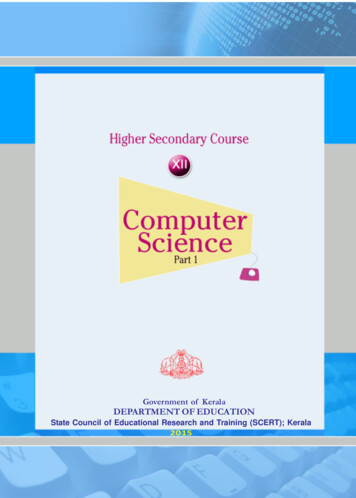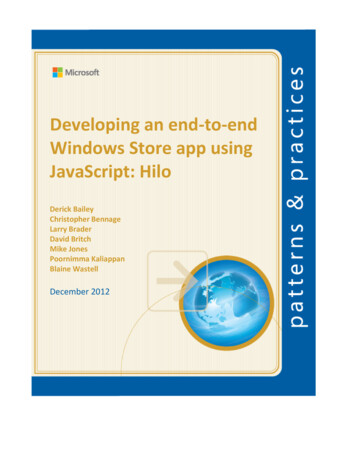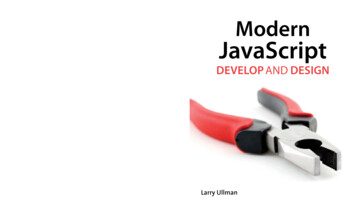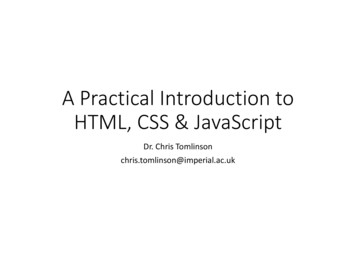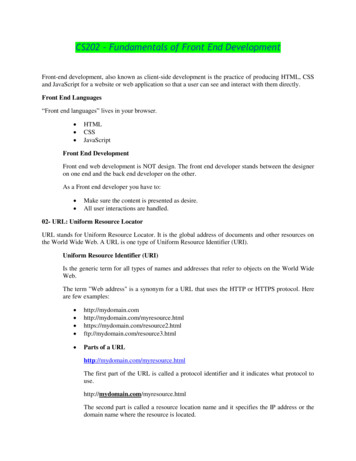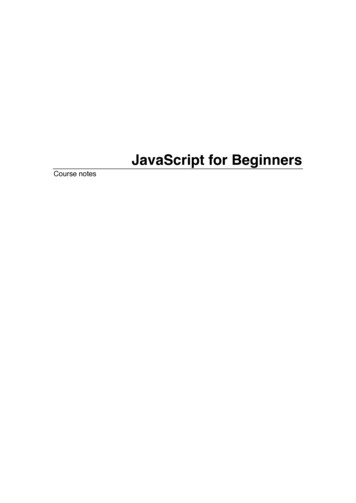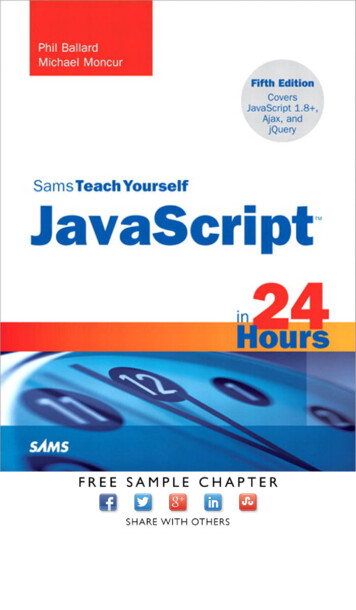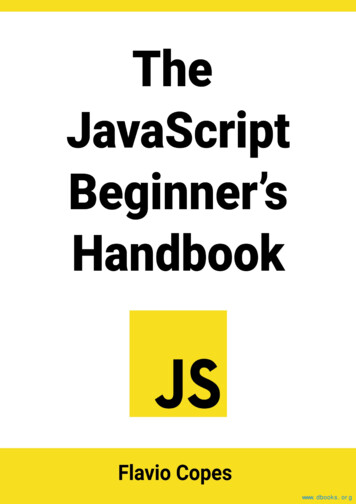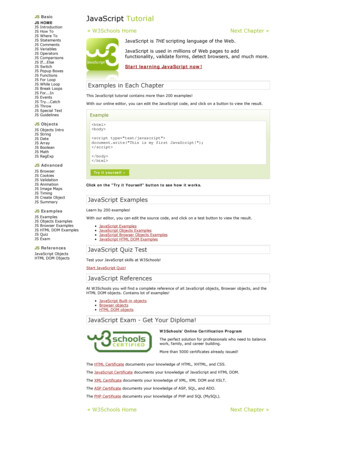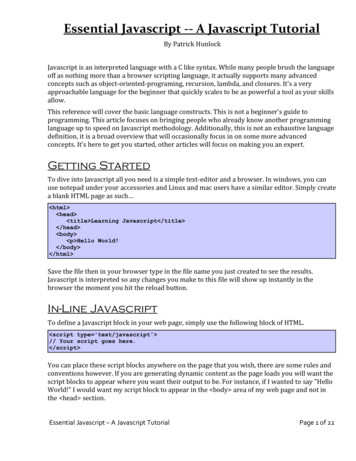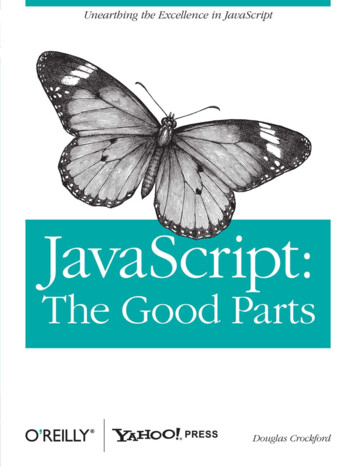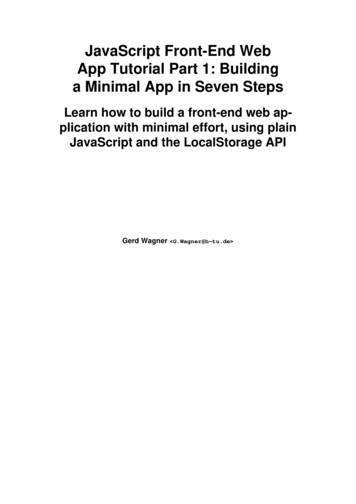
Transcription
JavaScript Front-End WebApp Tutorial Part 1: Buildinga Minimal App in Seven StepsLearn how to build a front-end web application with minimal effort, using plainJavaScript and the LocalStorage APIGerd Wagner G.Wagner@b-tu.de
JavaScript Front-End Web App Tutorial Part 1: Building a MinimalApp in Seven Steps: Learn how to build a front-end web applicationwith minimal effort, using plain JavaScript and the LocalStorageAPIby Gerd WagnerWarning: This tutorial may still contain errors and may still be incomplete in certain respects. Please report anyissue to Gerd Wagner at G.Wagner@b-tu.de.This tutorial is also available in the following formats: PDF. You may run the example app from our server, ordownload it as a ZIP archive file. See also our Web Engineering project page.Publication date 2021-04-12Copyright 2014-2021 Gerd WagnerThis tutorial article, along with any associated source code, is licensed under The Code Project Open License (CPOL), implying that theassociated code is provided "as-is", can be modified to create derivative works, can be redistributed, and can be used in commercial applications,but the article must not be distributed or republished without the author's consent.
Table of ContentsForeword . vii1. A Quick Tour of the Foundations of Web Apps . 11. The World Wide Web (WWW) . 12. HTML and XML . 12.1. XML documents . 12.2. Unicode and UTF-8 . 22.3. XML namespaces . 22.4. Correct XML documents . 32.5. The evolution of HTML . 32.6. HTML forms . 43. Styling Web Documents and User Interfaces with CSS . 64. JavaScript - "the assembly language of the Web" . 64.1. JavaScript as an object-oriented language . 74.2. Further reading about JavaScript . 75. Accessibility for Web Apps . 72. More on JavaScript . 91. JavaScript Basics . 91.1. Types and data literals in JavaScript . 91.2. Variable scope . 111.3. Frozen, or immutable, variables . 121.4. Strict Mode . 121.5. Different kinds of objects . 121.6. Array lists . 141.7. Maps . 151.8. Important types of basic data structures . 171.9. Procedures, methods and functions . 181.10. Defining and using classes . 201.10.1. Constructor-based classes . 221.10.2. Factory-based classes . 252. Storing Database Tables with JavaScript's localStorage API . 262.1. Entity Tables . 262.2. JavaScript's LocalStorage API . 263. A Minimal Web App with Plain JS . 281. Step 1 - Set up the Folder Structure . 282. Step 2 - Write the Model Code . 292.1. Representing the collection of all Book instances . 302.2. Creating a new Book instance . 312.3. Loading all Book instances . 312.4. Updating a Book instance . 322.5. Deleting a Book instance . 322.6. Saving all Book instances . 332.7. Creating test data . 332.8. Clearing all data . 343. Step 3 - Initialize the Application . 344. Step 4 - Implement the Create Use Case . 345. Step 5 - Implement the Retrieve/List All Use Case . 366. Step 6 - Implement the Update Use Case . 377. Step 7 - Implement the Delete Use Case . 388. Possible Variations and Extensions . 398.1. Using IndexedDB as an Alternative to LocalStorage . 39iii
JS Front-End Web Apps for Beginners8.2. Styling the User Interface .9. Points of Attention .9.1. Catching invalid data .9.2. Database size and memory management .9.3. Boilerplate code .9.4. Serializing and de-serializing attribute values .9.5. Implicit versus explicit form field labels .9.6. Synchronizing views with the model .9.7. Architectural separation of concerns .10. Practice Projects .10.1. Managing information about movies .10.2. Managing persistent data with IndexedDB .Glossary .iv39404040414141424243434445
List of Figures2.1. The built-in JavaScript classes Object and Function. . 243.1. The object type Book. . 283.2. The object type Movie. . 43v
List of Tables2.1. An example of an entity table representing a collection of books .2.2. Required and desirable features of JS code patterns for classes .3.1. A collection of book objects represented as a table .3.2. Sample data .vi17212844
ForewordThis tutorial is Part 1 of our series of six tutorials about model-based development of front-end webapplications with plain JavaScript. It shows how to build such an app with minimal effort, not using any(third-party) framework or library. While libraries and frameworks may help to increase productivity,they also create black-box dependencies and overhead, and they are not good for learning how to doit yourself.This tutorial provides theoretically underpinned and example-based learning materials and supportslearning by doing it yourself.A front-end web app can be provided by any web server, but it is executed on the user's computer device(smartphone, tablet or notebook), and not on the remote web server. Typically, but not necessarily, afront-end web app is a single-user application, which is not shared with other users.The minimal version of a JavaScript front-end data management application discussed in this tutorialonly includes a minimum of the overall functionality required for a complete app. It takes care of onlyone object type ("books") and supports the four standard data management operations (Create/Read/Update/Delete), but it needs to be enhanced by styling the user interface with CSS rules, and by addingfurther important parts of the app's overall functionality. The other parts of the tutorial are: Part 2: Handling constraint validation. Part 3: Dealing with enumerations. Part 4: Managing unidirectional associations, such as the associations between books and publishers,assigning a publisher to a book, and between books and authors, assigning authors to a book. Part 5: Managing bidirectional associations, such as the associations between books and publishersand between books and authors, not only assigning authors and a publisher to a book, but also theother way around, assigning books to authors and to publishers. Part 6: Handling subtype (inheritance) relationships between object types.vii
Chapter 1. A Quick Tour of the Foundations ofWeb AppsIf you are already familiar with HTML, XML and JavaScript, you may skip this chapter and immediatelystart developing a minimal web application by going to the next chapter.1. The World Wide Web (WWW)After the Internet had been established in the 1980'ies, Tim Berners-Lee developed the idea and the firstimplementation of the WWW in 1989 at the European research institution CERN in Geneva, Switzerland. The WWW (or, simply, "the Web") is based on the Internet technologies TCP/IP (the InternetProtocol) and DNS (the Domain Name System). Initially, the Web consisted of1. the Hypertext Transfer Protocol (HTTP),2. the Hypertext Markup Language (HTML), and3. web server programs, acting as HTTP servers, as well as web 'user agents' (such as browsers), actingas HTTP clients.Later, further important technology components have been added to this set of basic web technologies: the page/document style language Cascading Style Sheets (CSS) in 1995, the web programming language JavaScript in 1995, the Extensible Markup Language (XML), as the basis of web formats like SVG and RDF/XML, in1998, the XML-based Scalable Vector Graphics (SVG) format in 2001, the Resource Description Framework (RDF) for knowledge representation on the Web in 2004.2. HTML and XMLHTML allows to mark up (or describe) the structure of a human-readable web document or web userinterface, while XML allows to mark up the structure of all kinds of documents, data files and messages,whether they are human-readable or not. XML can also be used as the basis for defining a version ofHTML that is called XHTML.2.1. XML documentsXML provides a syntax for expressing structured information in the form of an XML document withnested elements and their attributes. The specific elements and attributes used in an XML documentcan come from any vocabulary, such as public standards or (private) user-defined XML formats. XMLis used for specifying document formats, such as XHTML5, the Scalable Vector Graphics (SVG) format or the DocBookformat, data interchange file formats, such as the Mathematical Markup Language (MathML) or the Universal Business Language (UBL),1
A Quick Tour of the Foundations of Web Apps message formats, such as the web service message format SOAP2.2. Unicode and UTF-8XML is based on Unicode, which is a platform-independent character set that includes almost all characters from most of the world's script languages including Hindi, Burmese and Gaelic. Each characteris assigned a unique integer code in the range between 0 and 1,114,111. For example, the Greek letterπ has the code 960, so it can be inserted in an XML document as π using the XML entity syntax.Unicode includes legacy character sets like ASCII and ISO-8859-1 (Latin-1) as subsets.The default encoding of an XML document is UTF-8, which uses only a single byte for ASCII characters,but three bytes for less common characters.Almost all Unicode characters are legal in a well-formed XML document. Illegal characters are thecontrol characters with code 0 through 31, except for the carriage return, line feed and tab. It is therefore dangerous to copy text from another (non-XML) text to an XML document (often, the form feedcharacter creates a problem).2.3. XML namespacesGenerally, namespaces help to avoid name conflicts. They allow to reuse the same (local) name indifferent namespace contexts. Many computational languages have some form of namespace concept,for instance, Java and PHP.XML namespaces are identified with the help of a namespace URI, such as the SVG namespace URI"http://www.w3.org/2000/svg", which is associated with a namespace prefix, such as svg. Such a namespace represents a collection of names, both for elements and attributes, and allows namespace-qualifiednames of the form prefix:name, such as svg:circle as a namespace-qualified name for SVG circleelements.A default namespace is declared in the start tag of an element in the following way: html xmlns "http://www.w3.org/1999/xhtml" This example shows the start tag of the HTML root element, in which the XHTML namespace is declaredas the default namespace.The following example shows an SVG namespace declaration for an svg element embedded in anHTML document: html xmlns "http://www.w3.org/1999/xhtml" head . /head body figure figcaption Figure 1: A blue circle /figcaption svg:svg xmlns:svg "http://www.w3.org/2000/svg" svg:circle cx "100" cy "100" r "50" fill "blue"/ /svg:svg /figure /body 2
A Quick Tour of the Foundations of Web Apps /html 2.4. Correct XML documentsXML defines two syntactic correctness criteria. An XML document must be well-formed, and if it isbased on a grammar (or schema), then it must also be valid with respect to that grammar, or, in otherwords, satisfy all rules of the grammar.An XML document is called well-formed, if it satisfies the following syntactic conditions:1. There must be exactly one root element.2. Each element has a start tag and an end tag; however, empty elements can be closed as phone/ instead of phone /phone .3. Tags don't overlap. For instance, we cannot have author name Lee Hong /author /name 4. Attribute names are unique within the scope of an element. For instance, the following code is notcorrect: attachment file "lecture2.html" file "lecture3.html"/ An XML document is called valid against a particular grammar (such as a DTD or an XML Schema), if1. it is well-formed,2. and it respects the grammar.2.5. The evolution of HTMLThe World-Wide Web Committee (W3C) has developed the following important versions of HTML: 1997: HTML 4 as an SGML-based language, 2000: XHTML 1 as an XML-based clean-up of HTML 4, 2014: (X)HTML 5 in cooperation (and competition) with the WHAT working group supported bybrowser vendors.As the inventor of the Web, Tim Berners-Lee developed a first version of HTML in 1990. A few years later,in 1995, Tim Berners-Lee and Dan Connolly wrote the HTML 2 standard, which captured the common useof HTML elements at that time. In the following years, HTML has been used and gradually extended bya growing community of early WWW adopters. This evolution of HTML, which has led to a messy setof elements and attributes (called "tag soup"), has been mainly controlled by browser vendors and theircompetition with each other. The development of XHTML in 2000 was an attempt by the W3C to clean upthis mess, but it neglected to advance HTML's functionality towards a richer user interface, which was thefocus of the WHAT working group led by Ian Hickson who can be considered as the mastermind and mainauthor of HTML 5 and many of its accompanying JavaScript APIs that made HTML fit for mobile apps.3
A Quick Tour of the Foundations of Web AppsHTML was originally designed as a structure description language, and not as a presentation descriptionlanguage. But HTML4 has a lot of purely presentational elements such as font. XHTML has beentaking HTML back to its roots, dropping presentational elements and defining a simple and clear syntax,in support of the goals of device independence, accessibility, and usability.We adopt the symbolic equationHTML HTML5 XHTML5stating that when we say "HTML" or "HTML5", we actually mean XHTML5because we prefer the clear syntax of XML documents over the liberal and confusing HTML4-stylesyntax that is also allowed by HTML5.The following simple example shows the basic code template to be used for any HTML document: !DOCTYPE html html xmlns "http://www.w3.org/1999/xhtml" xml:lang "en" lang "en" head meta charset "UTF-8" / title XHTML5 Template Example /title meta name "viewport" content "width device-width, initial-scale 1"/ /head body h1 XHTML5 Template Example /h1 section h2 First Section Title /h2 . /section /body /html Notice that in line 1, the HTML5 document type is declared, such that browsers are instructed to usethe HTML5 document object model (DOM). In the html start tag in line 2, using the default namespacedeclaration attribute xmlns, the XHTML namespace URI http://www.w3.org/1999/xhtml is declaredas the default namespace for making sure that browsers, and other tools, understand that all non-qualifiedelement names like html, head, body, etc. are from the XHTML namespace.Also in the html start tag, we set the (default) language for the text content of all elements (here to "en"standing for English) using both the xml:lang attribute and the HTML lang attribute. This attributeduplication is a small price to pay for having a hybrid document that can be processed both by HTMLand by XML tools.Finally, in line 4, using an (empty) meta element with a charset attribute, we set the HTML document'scharacter encoding to UTF-8, which is also the default for XML documents.2.6. HTML formsFor user-interactive web applications, the web browser needs to render a user interface (UI). The traditional metaphor for a software application's UI is that of a form. The special elements for data input, data4
A Quick Tour of the Foundations of Web Appsoutput and user actions are called form controls or UI widgets. In HTML, a form element is a sectionof a web page consisting of block elements that contain form controls and labels on those controls.Users complete a form by entering text into input fields and by selecting items from choice controls,including dropdown selection lists, radio button groups and checkbox groups. A completed form issubmitted with the help of a submit button. When a user submits a form, it is normally sent to a webserver either with the HTTP GET method or with the HTTP POST method. The standard encoding forthe submission is called URL-encoded. It is represented by the Internet media type application/xwww-form-urlencoded. In this encoding, spaces become plus signs, and any other reserved charactersbecome encoded as a percent sign and hexadecimal digits, as defined in RFC 1738.Each form control has both an initial value and a current value, both of which are strings. The initialvalue is specified with the control element's value attribute, except for the initial value of a textareaelement, which is given by its initial contents. The control's current value is first set to the initial value.Thereafter, the control's current value may be modified through user interaction or scripts. When a formis submitted for processing, some controls have their name paired with their current value and thesepairs are submitted with the form.Labels are associated with a control by including the control as a child element within a label element(implicit labels), or by giving the control an id value and referencing this ID in the for attribute of thelabel element (explicit labels).In the simple user interfaces of our "Getting Started" applications, we only need four types of formcontrols:1. single line input fields created with an input name "." / element,2. single line output fields created with an output name "." / element,3. push buttons created with a button type "button" . /button element, and4. dropdown selection lists created with a select element of the following form: select name "." option value "value1" option1 /option option value "value2" option2 /option . /select An example of an HTML form with implicit labels for creating such a user interface is form id "Book" p label ISBN: output name "isbn" / /label /p p label Title: input name "title" / /label /p p label Year: input name "year" / /label /p p button type "button" Save /button /p /form In an HTML-form-based data management user interface, we have a correspondence between the different kinds of properties defined in the model classes of an app and the form controls used for the inputand output of their values. We have to distinguish between various kinds of model class attributes,which are mapped to various kinds of form fields. This mapping is also called data binding.In general, an attribute of a model class can always be represented in the user interface by a plain inputcontrol (with the default setting type "text"), no matter which datatype has been defined as the range5
A Quick Tour of the Foundations of Web Appsof the attribute in the model class. However, in special cases, other types of input controls (for instance,type "date"), or other widgets, may be used. For instance, if the attribute's range is an enumeration,a select control or, if the number of possible choices is small enough (say, less than 8), a radio buttongroup can be used.3. Styling Web Documents and User Interfaces with CSSWhile HTML is used for defining the content structure of a web document or a web user interface, theCascading Style Sheets (CSS) language is used for defining the presentation style of web pages, whichmeans that you use it for telling the browser how you want your HTML (or XML) rendered: using whichlayout of content elements, which fonts and text styles, which colors, which backgrounds, and whichanimations. Normally, these settings are made in a separate CSS file that is associated with an HTMLfile via a special link element in the HTML's head.A first sketch of CSS was proposed in October 1994 by Håkon W. Lie who later became the CTO of thebrowser vendor Opera. While the official CSS1 standard dates back to December 1996, "most of it washammered out on a whiteboard in Sophia-Antipolis" by Håkon W. Lie together with Bert Bos in July 1995(as he explains in an interview).CSS is based on a form of rules that consist of selectors, which select the document element(s) to whicha rule applies, and a list of property-value pairs that define the styling of the selected element(s) withthe help of CSS properties such as font-size or color. There are two fundamental mechanisms forcomputing the CSS property values for any page element as a result of applying the given set of CSSrules: inheritance and the cascade.The basic element of a CSS layout is a rectangle, also called "box", with an inner content area, anoptional border, an optional padding (between content and border) and an optional margin around theborder. This structure is defined by the CSS box model.We will not go deeper into CSS in this tutorial, since our focus here is on the logic and functionalityof an app, and not so much on its beauty.4. JavaScript - "the assembly language of the Web"JavaScript was developed in 10 days in May 1995 by Brendan Eich, then working at Netscape, as the HTMLscripting language for their browser Navigator 2 (more about history). Brendan Eich said (at the O'ReillyFluent conference in San Francisco in April 2015): "I did JavaScript in such a hurry, I never dreamed itwould become the assembly language for the Web".JavaScript is a dynamic functional object-oriented programming language that can be used for1. Enriching a web page by generating browser-specific HTML content or CSS styling, inserting dynamic HTML content, producing special audio-visual effects (animations).6
A Quick Tour of the Foundations of Web Apps2. Enriching a web user interface by implementing advanced user interface components, validating user input on the client side, automatically pre-filling certain form fields.3. Implementing a front-end web application with local or remote data storage, as described in the bookBuilding Front-End Web Apps with Plain JavaScript.4. Implementing a front-end component for a distributed web application with remote data storagemanaged by a back-end component, which is a server-side program that is traditionally written ina server-side language such as PHP, Java or C#, but can nowadays also be written in JavaScriptwith NodeJS.5. Implementing a complete distributed web application where both the front-end and the back-endcomponents are JavaScript programs.The version of JavaScript that is currently fully supported by modern web browsers is called "ECMAScript 2015", or simply "ES2015", but the following versions, ( ES2016, ES2017, .), are alreadypartially supported by current browsers and back-end JS environments.4.1. JavaScript as an object-oriented languageJavaScript is object-oriented, but in a different way than classical OO programming languages such asJava and C . In JavaScript, classes, unlike objects and functions, have not been first-class citizens untilES2015 has introduced a class syntax. Before ES2015, classes had to be defined by following a codepattern in the form of special JS objects: either as constructor functions or as factory objects. Noticethat when using (the syntactic sugar of) ES2015 class declarations, what is really defined internally,is still a constructor function.However, objects can also be created without instantiating a class, in which case they are untyped, andproperties as well as methods can be defined for specific objects independently of any class definition. Atrun time, properties and methods can be added to, or removed from, any object and class. This dynamismof JavaScript allows powerful forms of meta-programming, such as defining your own concepts ofclasses and enumerations (and other special datatypes).4.2. Further reading about JavaScriptGood open access books about JavaScript are Speaking JavaScript, by Dr. Axel Rauschmayer. Eloquent JavaScript, by Marijn Haverbeke. Building Front-End Web Apps with Plain JavaScript, by Gerd Wagner5. Accessibility for Web AppsThe recommended approach to providing accessibility for web apps is defined by the Accessible RichInternet Applications (ARIA) standard. As summarized by Bryan Garaventa in his article on differentforms of accessibility, there are 3 main aspects of accessibility for interactive web technologies: 1)keyboard accessibility, 2) screen reader accessibility, and 3) cognitive accessibility.7
A Quick Tour of the Foundations of Web AppsFurther reading on ARIA:1. How browsers interact with screen readers, and where ARIA fits in the mix by Bryan Garaventa2. The Accessibility Tree Training Guide by whatsock.com3. The ARIA Role Conformance Matrices by whatsock.com4. Mozilla's ARIA overview article5. W3C's ARIA Authoring Practices8
Chapter 2. More on JavaScript1. JavaScript BasicsIn this summary we try to take all important points of the classical JavaScript summary by DouglasCrockford into consideration.1.1. Types and data literals in JavaScriptJavaScript has three primitive datatypes: string, number and boolean, and we can test if a variable
with minimal effort, using plain JavaScript and the LocalStorage API by Gerd Wagner Warning: This tutorial may still contain errors and may still be incomplete in certain respects. Please report any issue to Gerd Wagner at G.Wagner@b-tu.de. This tutorial is also available in the following formats: PDF. You may run the example app from our .
